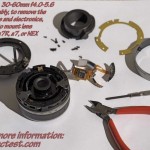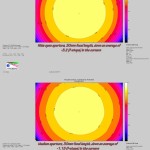24mm lens sample variation: Three Sigma 24mm lens and three Canon FDn 24mm lenses compared
The goal of this comparison is to see how multiple copies from two different brands compare. We are looking at how the sides of the lenses compare in particular, since wide angle DSLR lenses are problematic on the 36mp sensor in the Sony a7R.
Since we only have six lenses total to compare, on one camera, using two different cheap adapters, it won’t be possible to draw any statistically significant conclusions. The best that can be hoped for is for the viewer to see possible trends, and to get a good idea of what to look for when evaluating an image.
Sigma 24mm f/2.8 SuperWide II: If you have a Pentax background, you’ll probably know that this lens is legendary. It was highly rated in the photozone.de crop sensor camera test, and it has a 4.0 rating on the old Photodo testing site. We are comparing two autofocus versions and one manual focus version, all with the Pentax k-mount flange. This prime lens was sold in just about every mount option that was popular at the time.
Canon FDn 24mm f/2.8: You won’t have any problem locating one of these lenses, because Canon made a whole lot of them. Since there are so many, the pricing is fairly good, especially when you compare it to the astronomical cost of, say, some versions of the Minolta 24mm f/2.8 lens. All three of the lenses being tested here use the same Canon FDn mount, so they are the later versions, but this glass is also available in the earlier FD mount.
Results: Compare the “5610” street number on the back of the center building. On the left side of the images, look at the street sign hanging on the steet light. For the right side, perhaps the “USED CARS” sign on the side of the building. Canon wins for consistency here, the left side is basically the same in all three FDn 24mm images. The center varies somewhat, while the right side is perhaps the weakest for all three copies of the lens. That kind of consistency begs the question of whether there could be a Sony NEX to FDn adapter issue, or perhaps the a7R sensor isn’t perfectly parallel to the lens mounting flange on the camera. Copy “B” will be used for further 24mm lens comparison testing.
The Sigma 24mm lens group generated mixed results, with “B” winning on the left side. “C” wins on the right side, but there was a thin cloud overhead, which cut the sunlight down over most of the image, changing the contrast. “B” advances to the consolation round, but just barely. The Sigma 24mm f/2.8 appears to have more vignetting issues than the Canon FDn 24mm f/2.8 lens does.
https://www.codectest.com/images/24mmLensComparisonThreeCopiesOfCanonFDn24mm.jpg
https://www.codectest.com/images/24mmLensComparisonThreeCopiesOfSigma24mmSuperWide2.jpg
Dan Euritt
24mm camera lens shootout, on the Sony a7R: first round
24mm camera lens shootout, on the Sony a7R: second round
24mm camera lens shootout on the Sony a7R: third round, Konica 24mm
24mm SLR prime lens test, fourth round, shot on the Sony a7R






